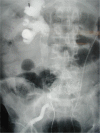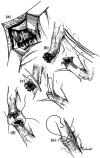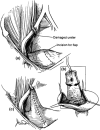Management of iatrogenic ureteral injury
- PMID: 24883109
- PMCID: PMC4003841
- DOI: 10.1177/1756287214526767
Management of iatrogenic ureteral injury
Abstract
Iatrogenic injury to the ureter is a potentially devastating complication of modern surgery. The ureters are most often injured in gynecologic, colorectal, and vascular pelvic surgery. There is also potential for considerable ureteral injury during endoscopic procedures for ureteric pathology such as tumor or lithiasis. While maneuvers such as perioperative stenting have been touted as a means to avoid ureteral injury, these techniques have not been adopted universally, and the available literature does not make a case for their routine use. Distal ureteral injuries are best managed with ureteroneocystostomy with or without a vesico-psoas hitch. Mid-ureteral and proximal ureteral injuries can potentially be managed with ureteroureterostomy. If the distal segment is unsuitable for anastomosis then a number of techniques are available for repair including a Boari tubularized bladder flap, transureteroureterostomy, or renal autotransplantation. In rare cases renal autotransplantation or ureteral substitution with gastrointestinal segments may be warranted to re-establish urinary tract continuity. Laparoscopic and minimally invasive techniques have been employed to remedy iatrogenic ureteral injuries.
Keywords: iatrogenic; surgical management; trauma; ureter.
Conflict of interest statement
Figures







References
-
- Ahn M., Loughlin K. (2001) Psoas hitch ureteral reimplantation in adults – analysis of a modified technique and timing of repair. Urology 58: 184–187 - PubMed
-
- Barry J. (2005) Surgical atlas transureteroureterostomy. BJU Int 96: 195–201 - PubMed
-
- Chou M., Wang C., Lien R. (2009) Prophylactic ureteral catheterization in gynecologic surgery: a 12-year randomized trial in a community hospital. Int Urogynecol J 20: 689–693 - PubMed
Publication types
LinkOut - more resources
Full Text Sources
Other Literature Sources

